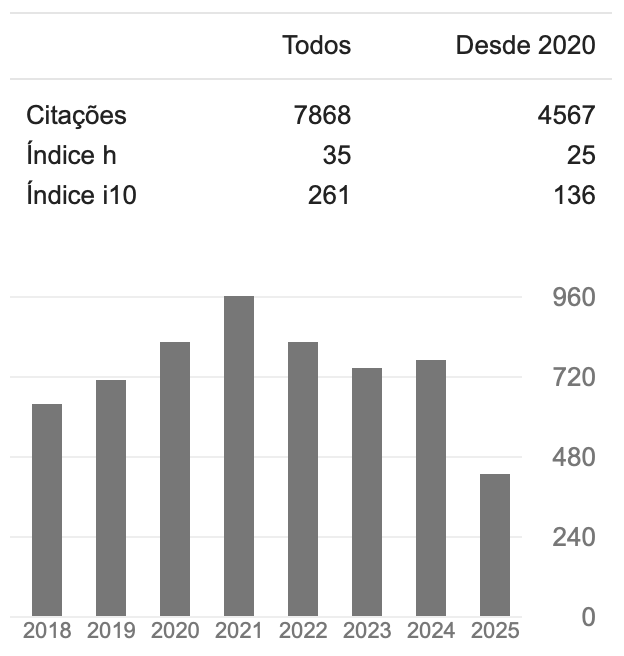Intervenção viabilizada por WhatsApp® para promoção da adesão às medidas preventivas na pandemia da COVID-19: um estudo piloto
DOI:
https://doi.org/10.17765/2176-9206.2023v16n3.e11354Palavras-chave:
COVID-19, Fatores de proteção, Infecções por coronavírus, SARS-CoV-2Resumo
Analisar o potencial de eficácia do envio de mensagens validadas (texto e imagens), via WhatsApp®, na promoção da adesão ao uso de máscaras, distanciamento social e associar às variáveis sociodemográficas. Trata-se de um estudo com desenho quase-experimental, do tipo pré e pós-teste com 132 participantes, acompanhados por 60 dias. As mensagens foram enviadas semanalmente junto com os formulários de adesão. Ao final da intervenção os participantes responderam ao questionário de satisfação da pesquisa. Foram realizados testes de comparação e análises descritivas. Os achados deste estudo demonstraram impacto positivo da intervenção no envio de mensagens validadas, via WhatsApp®, na adesão ao uso de máscaras e distanciamento social durante a pandemia da COVID-19. A intervenção proposta neste estudo apresenta potencial de eficácia para adesão às medidas preventivas contra o vírus do SARS-CoV-2 e constitui uma ferramenta valiosa para profissionais de saúde atuarem no combate à pandemia.Downloads
Referências
1. Aquino EML, Silveira IH, Pescarini JM, Aquino R, Filho JA, Rocha AS, et al. Sociais distancing measures to control the COVID-19 pandemic: potential impacts and challenges in Brazil. Ciênc. Saúde Colet. 2020;25(1):242-284. https://doi.org/10.1590/1413-81232020256.1.10502020.
2. World Health Organization. Transmission of SARS-CoV-2: implications for infection prevention precautions: scientific brief. World Health Organization. [internet]. 2020 [cited 2021 Aug 21] Available from: https://apps.who.int/iris/handle/10665/333114
3. Galindo NM, Guilherme GM, Barbosa LU, Pereira JCN, Henriques AHB. Covid-19 and digital technology: Mobile applications available for download in smartphones. Texto & contexto enferm. 2020;29:1-12. https://doi.org/10.1590/1980-265X-TCE-2020-0150.
4. Domingues CMAS. Challenges for implementation of the COVID-19 vaccination campaign in Brazil. Cad. Saúde Pública. 2021;37(1). https://doi.org/10.1590/0102-311X00344620.
5. Beckham R, Riedford K. Evolution of a graduate-level informatics course for the noninformatics specialist nurse. J Nurse Pract. 2014;10(6):387-92. https://doi.org/10.1016/j.nurpra.2014.03.012.
6. Cavalcante RB, Pinheiro MMK, Watanabe YJA, Silva CJ. Group technical information on health and population: contributions to the national information policy and health informatics Perspect. Ciênc. Inf. [internet]. 2015;20(1):92-119. https://doi.org/10.19175/recom.v0i0.598
7. Lima ICV, Galvão MTG, Pedrosa SC, Cunha GH. Use of the WhatsApp application in health follow-up of people with HIV: a thematic analysis. Esc. Anna Nery Rev. Enferm. 2018;22(3):1-6. https://doi.org/10.1590/2177-9465-EAN-2017-0429.
8. Sana Saeed MBBS, Noureen SFCPS. Evaluating the Effectiveness of Text Messaging and Phone Call Reminders to Minimize No Show at Pediatric Outpatient Clinics in Pakistan: Protocol for a Mixed-Methods Study. JMIR Res Protoc. 2018;7(4):e91. https://doi.org/10.2196/resprot.9294.
9. Stringhini MLF, Chagas JS, Reis MJM, Brito PRT. Whatsapp® as a Tool for Promoting Health in Diabetes: Experience Report. 2020;(19);1-15. https://doi.org/10.5216/revufg.v19i0.56925.
10. Savio RO, Barreto MFC, Pedro DRC, Costa RG, Rossaneis MA, Silva LGC, et al. Use of WhatsApp® by health care managers. Acta Paul. Enferm. [online]. 2021;(34):eAPE001695. https://doi.org/10.37689/acta-ape/2021AO001695.
11. Des Jarlais DC, Lyles C, Crepaz N; TREND Group. Improving the reporting quality of nonrandomized evaluations of behavioral and public health interventions: the TREND statement. Am J Public Health. 2004;94(3):361-6. https://ajph.aphapublications.org/doi/full/10.2105/AJPH.94.3.361
12. Talic S, Shah S, Wild H, Gasevic D, Maharaj A, Ademi Z, et al. Effectiveness of public health measures in reducing the incidence of covid-19, SARS-CoV-2 transmission, and covid-19 mortality: systematic review and meta-analysis. BMJ. 2021;375:e068302. https://doi.org/10.1136/bmj-2021-068302
13. Chu DK, Akl EA, Duda S, Solo K, Yaacoub S, Schünemann HJ, et al. Physical distancing, face masks, and eye protection to prevent person-to-person transmission of
SARS-CoV-2 and COVID-19: a systematic review and meta-analysis. Lancet. 2020 Jun 2020; 395: 1973–87. https://doi.org/10.1016/S0140-6736(20)31142-9.
14. Doung-Ngern P, Suphanchaimat R, Panjangampatthana A, Janekrongtham C, Ruampoom D, Daochaeng N, et al. Case-Control Study of Use of Personal Protective Measures and Risk for SARS-CoV 2 Infection, Thailand. Emerg Infect Dis. 2020;26(11):2607-2616. https://doi.org/10.3201/eid2611.203003.
15. Nivette A, Ribeaud D, Murray A, Steinhoff A, Bechtiger L, Hepp U, et al. Non-compliance with COVID-19-related public health measures among young adults in Switzerland: Insights from a longitudinal cohort study. Soc Sci Med. 2021;68:113-370. https://doi.org/10.1016/j.socscimed.2020.113370.
16. Xu H, Gan Y, Zheng D, Wu B, Zhu X, Xu C, et al. Relationship Between COVID-19 Infection and Risk Perception, Knowledge, Attitude, and Four Nonpharmaceutical Interventions During the Late Period of the COVID-19 Epidemic in China: Online Cross-Sectional Survey of 8158 Adults. J Med Internet Res. 2020;22(11):e21372. doi: 10.2196/21372.
17. Coroiu A, Moran C, Campbell T, Geller AC. Barriers and facilitators of adherence to social distancing recommendations during COVID-19 among a large international sample of adults. PLoS One. 2020;15(10):239-795. https://doi.org/10.1371/journal.pone.0239795
18. Haucke M, Golde S, Saft S, Hellweg R, Liu S, Heinzel S. The effects of momentary loneliness and COVID-19 stressors on hypothalamic-pituitary adrenal (HPA) axis functioning: A lockdown stage changes the association between loneliness and salivary cortisol. Psychoneuroendocrinology. 2022;145:105894. https://doi.org/10.1016/j.psyneuen.2022.105894
19. McKenna-Plumley PE, Graham-Wisener L, Berry E, Groarke JM. Connection, constraint, and coping: A qualitative study of experiences of loneliness during the COVID-19 lockdown in the UK. PLoS One. 2021;16(10):e0258344. https://doi.org/10.1371/journal.pone.0258344
20. Ryal JJ, Perli VAS, Marques DCdS, Sordi AF, Marques MGdS, Camilo ML, et al. Effects of a Multi-Professional Intervention on Mental Health of Middle-Aged Overweight Survivors of COVID-19: A Clinical Trial. Int J Environ Res Public Health. 2023;20(5):4132. https://doi.org/10.3390/ijerph20054132
21. Ross JR, Safádi MAP, Marinelli NP, Albuquerque LPA, Batista FMA, Rodrigues MTP. Fake news and infodemia in times of covid-19 in Brazil: ministry of health indicators. REME Rev Min Enferm. 2021;25(1):e-138. DOI: 10.5935/1415.2762.20210029
22. Kim S, Lee S. Effects of Government-Driven Smartphone Text Messages on Public Compliance With COVID-19 Preventative Measures. Comput Inform Nurs. 2021; 39(10):527-537. DOI: 10.1097/CIN.0000000000000799
23. Willoughby JF, King RL, Adams PM. Development of an mHealth text message intervention to promote adherence to COVID-19 isolation recommendations for college students. J Am Coll Health. 2022;8:1-5. DOI: https://doi.org/10.1080/07448481.2022.2037615
Downloads
Publicado
Como Citar
Edição
Seção
Licença
A submissão de originais para a revista Saúde e Pesquisa implica na transferência da Carta Concessão de Direitos Autorais, pelos autores, dos direitos de publicação digital para a revista após serem informados do aceite de publicação.A Secretaria Editorial irá fornecer da um modelo de Carta de Concessão de Direitos Autorais, indicando o cumprimento integral de princípios éticos e legislação específica. Os direitos autorais dos artigos publicados nesta revista são de direito do autor, com direitos da revista sobre a primeira publicação. Os autores somente poderão utilizar os mesmos resultados em outras publicações, indicando claramente a revista Saúde e Pesquisa como o meio da publicação original. Em virtude de tratar-se de um periódico de acesso aberto, é permitido o uso gratuito dos artigos, principalmente em aplicações educacionais e científicas, desde que citada a fonte. A Saúde e Pesquisa adota a licença Creative Commons Attribution 4.0 International.
A revista se reserva o direito de efetuar, nos originais, alterações de ordem normativa, ortográfica e gramatical, com vistas a manter o padrão culto da língua e a credibilidade do veículo. Respeitará, no entanto, o estilo de escrever dos autores. Alterações, correções ou sugestões de ordem conceitual serão encaminhadas aos autores, quando necessário. Nesses casos, os artigos, depois de adequados, deverão ser submetidos a nova apreciação. As opiniões emitidas pelos autores dos artigos são de sua exclusiva responsabilidade.


















